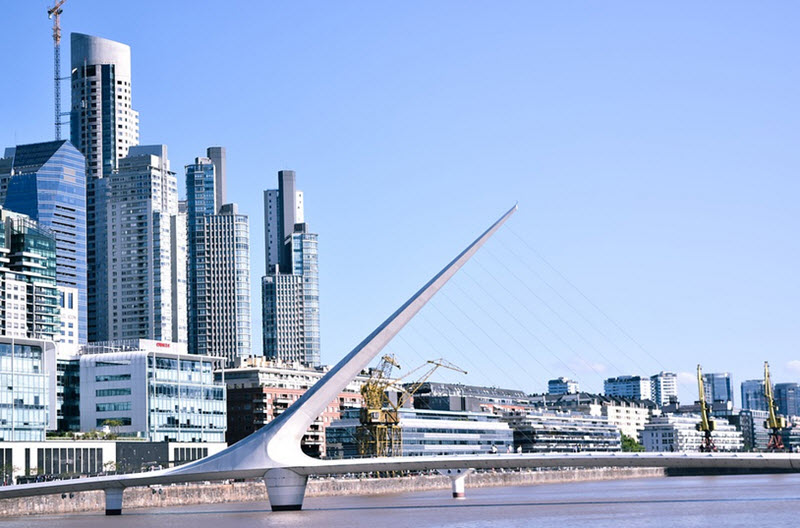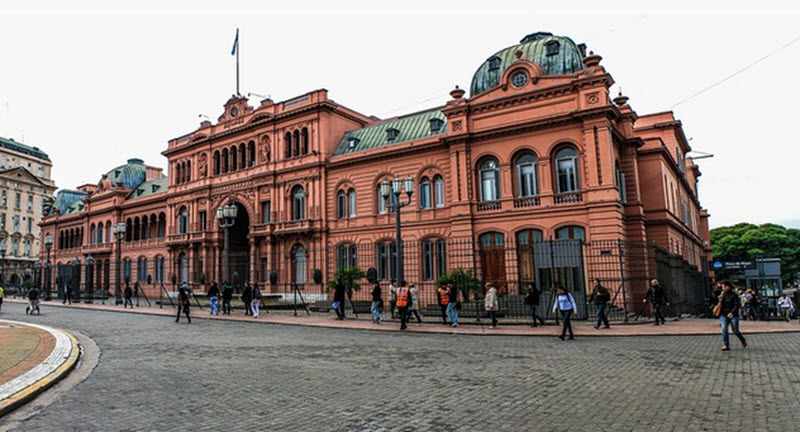Buenos Aires is the capital of Argentina and also the country´s most populous city. Located on South America´s south-eastern shore, where Río de la Plata meets the Atlantic, the city is an important port and its inhabitants are known in the rest of Argentina as porteños – people of the port.
The Greater Buenos Aires conurbation is one of the most populous metropolitan areas in the Americas, and also one of the most visited metropolitan areas in Latin America.

What´s the weather like?
Buenos Aires is located within the pampas region and heavily influenced by the Atlantic Ocean. The climate is humid subtropical with a summer season and a winter season (that never gets very cold).
Summer season
The summer season lasts from December to February. The average high is 30°C (86°F), but heat waves sometimes bring the temperature up above 35°C (95°F).
Powerful thunderstorms with heavy rains are common during the summer season.
Winter season
The winter season is cooler than the summer season, but not overly so. When it snowed in Buenos Aires in 2007, it was the first major snow in the city since 1918. Typically, the temperature will not drop below 5°C (42°F) even during the nights, and it goes up towards 15°C (60°F) during the days. The southern outskirts of Buenos Aires are known to be a bit chillier than the rest of the metropolitan area.
The winter season is a generally a dry season, but June, July and August usually gets more than 60 mm of rain.
Barrios of Buenos Aires
The City of Buenos Aires is divided into 48 neighbourhoods (”barrios”). Here are a few examples of barrios that tend to attract many visitors.
Microcentro
This part of the city is ideal for many visitors, as it is filled with historical spots and also a hub for public transport. The famous pedestrian street Florida is famous for its shopping.

San Telmo
This district contains a lot of well-preserved colonial-style buildings, flanking narrow cobblestone streets. The nightlife is known for its vibrancy.
Almagro
This is the place to go for cheap street food (parillas, empanadas, etc). During Sundays, the park turns into a market.
Boedo
This barrio is strongly associated with Argentine tango.
Congreso
This part of downtown is where the legislative branch of the government works, in the famous Casa Rosada.
Puerto Madero
This is the old port district. In recent years, urban revival has brought in expensive hotels, fancy apartment buildings and a wide range of restaurants. The nature preserve Reserva Ecológica Costanera Sur is nearby.
Tribunales
A lot of theatres are found in this barrio, especially on Avenida Corrientes. The famous opera house Teatro Colón is on Calle Libertad.
Palermo
The tree-lined streets of Palermo are flanked by residential buildings that have restaurants, bars and shopping at the street level. Don´t miss the locally made craft beer.
La Boca
The working class neighbourhood of La Boca is known for its colourful buildings and cheap local-style food. Before you visit, do your research, because some parts of La Boca are more crime prone than others and should ideally be avoided.
Recoleta
Real estate prices in Recoleta are much higher than average in Buenos Aires, and the neighbourhood is known for having excellent green spaces – a scarcity in many other parts of this densely built capital. The Recoleta Cemetery contains the graves of many notable Argentinians, including Eva Perón, several presidents, and the Nobel Prize winners L.F Leloir and C.S Lamas.
Tip! If you like Recoleta, you will probably also like Belgrano which as a similar feel to it with large green spaces and tree-lined side walks.
Cultural Buenos Aires
Buenos Aires is home to one of Latin America’s largest and liveliest theatre industries. During an average weekend, you can chose from over 275 theatre performances here, ranging from large to micro productions. Buenos Aires is also home to a number of cultural festivals throughout the year.
Buenos Aires has several symphony orchestras, choral societies and a top-rated opera house. The selection of museums includes a wide range of subjects, such as Argentine history, modern art, sacred art, arts & crafts, theatre history, and musical history.
Here are just a few examples of how you can enjoy cultural experiences within the city:
- Centro Cultural Kirchner. Located in the former Buenos Aires Central Post Office, this is a nine-floor cultural hub with a large concert hall, five smaller auditoriums for theatre and music, and 18 halls for other cultural activities, such as performance art and poetry readings. There are also 40 rooms dedicated to art and history exhibitions. The closest subway stops are Leandro N. Alem (Line B) and Correo Central (Line E).
- Teatro Colón, Argentina´s main opera house. In a ranking by National Geographic, it was placed among the world´s ten best opera houses. Acoustically, it is consider among the top-five concert venues.
- Take a street art tour. Buenos Aires has an amazing range of street art, including huge murals covering tall buildings. Several organisations are offering street art tours that will take you to notable examples of Buenos Aires street art, including murals found in neighbourhoods typically not visited by tourists.
